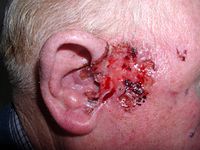
Photo from wikipedia
One of the most predominant types of cancer affecting women is breast cancer. In computer‐assisted analysis of pathology, the most crucial task is classifying breast cancer automatically from the histopathological… Click to show full abstract
One of the most predominant types of cancer affecting women is breast cancer. In computer‐assisted analysis of pathology, the most crucial task is classifying breast cancer automatically from the histopathological images. Most of the patients experienced everlasting effects and loss of life because of the absence of timely detection and thereby delay in treatment. Thus, the timely detection as well as precise identification of breast cancer using the histopathological image is highly required. An improved invasive weed water wave optimization (IIWWWO) algorithm is devised here, which is employed in training the Shepard convolutional neural networks (ShCNN) classifier. The developed optimization algorithm combines the improved invasive weed optimization algorithm and water wave optimization algorithm. Initially, the Bayesian filtering process is applied in the input image to remove the noises present in the input image. Moreover, the Hessian‐based Laplacian of Gaussian texture feature model is utilized in segmenting blood cells for an effective classification process. The shape features, namely shape area, diameter, and perimeter, are effectively extracted for better performance. Besides, ShCNN classifier is the most important one for classifying breast cancers. The proposed IIWWWO optimization technique is utilized in tuning the employed classifier termed as ShCNN classifier. Classification of breast cancer is accomplished using two levels, such as malignant and benign. The developed IIWWWO‐based ShCNN model is compared with various metrics, like accuracy, true negative rate (TNR) and true positive rate (TPR). The developed technique used to classify breast cancer obtained better accuracy of 95.83%, maximal TPR of 94.72%, and high TNR of 93.15%.
Journal Title: International Journal of Imaging Systems and Technology
Year Published: 2022
Link to full text (if available)
Share on Social Media: Sign Up to like & get
recommendations!